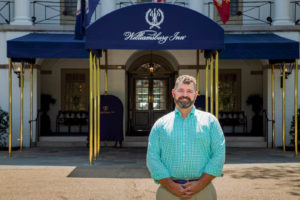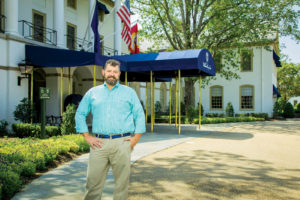
“We have to be diverse and knowledgeable about the various types of products people are making in the industry,” says Taylor Bigley, co-owner and president of Awnings by Bigley & Hogshire, Hampton Roads, Va. “What’s in demand changes—the pendulum swings each way—and we have to react to it.”
The roots of Awnings by Bigley & Hogshire are deep and varied, and its ability to stay current on trends and respond to the needs of the communities it serves is one of the company’s many strengths. The foundation of what the business is today began in 1898 when Edward Hogshire opened a sail loft on the docks of Norfolk, Va. (The company joined IFAI in 1923.) Its products transitioned from sails to wartime military tents for two World Wars through Vietnam, to what became its primary focus—awnings and shade products. The company operated for years as Hogshire Industries, under the leadership of third-generation owner “Happy” Hogshire.
Passing the torch—outside the family
Bigley’s introduction to the shade and awning industry came after he and his brothers launched Invisible Fence Brand of Hampton Roads in the mid ’90s, which later began selling retractable awnings as an adjunct to the company’s revenue. The awning portion of the business grew quickly, added custom awnings to the mix, and in 2005 the brothers separated operations of the two businesses, with Bigley taking charge of the awning business.
When Happy Hogshire died in 2010, Bigley and his brothers purchased the company and renamed it Awnings by Bigley & Hogshire. “At that time we were what I would call ‘good competitors’ with Hogshire Industries,” Bigley says. “Happy’s daughters wanted to find good stewards of their family business, and they decided we would be the best fit.”
 Not only did the purchase allow for a way to preserve the heritage and history of the Hogshire family business, it also offered Bigley an opportunity to break into what had previously been a difficult market area for him. “In many market areas, such as Virginia Beach, our awning business was quite successful,” Bigley says. “But we had a harder time selling in the Norfolk area because Hogshire Industries was so well known and trusted. Everyone there knew the family and the business, so why would they buy from anyone else?”
Not only did the purchase allow for a way to preserve the heritage and history of the Hogshire family business, it also offered Bigley an opportunity to break into what had previously been a difficult market area for him. “In many market areas, such as Virginia Beach, our awning business was quite successful,” Bigley says. “But we had a harder time selling in the Norfolk area because Hogshire Industries was so well known and trusted. Everyone there knew the family and the business, so why would they buy from anyone else?”
When Bigley took over, he moved the manufacturing location to a new building, and not all of the existing staff joined them “though we didn’t refuse anyone,” Bigley says. “Those who came with us were talented, great staff, and they were important for continuity and knowledge of the customers.”
Though Bigley’s brothers are not involved in the day-to-day workings of the company, they offer advice and act as sounding boards and ambassadors of the products. “I’ve found that it can be difficult to find reliable sources for business advice,” he says. “My brothers understand the operational struggles of running a business and they offer great perspectives.”
Bigley also credits his wife Joanna’s expertise for the business’s ongoing success. “We both had previously worked for a Fortune 500 company and she gained management experience in HR, payroll, bookkeeping and accounting,” he says. “To have her working with me is invaluable. Like me, she does what it takes to get the job done.”
Tricks of the trends
Two industry trends that have driven changes at the company include the rise of shade sails and the resurgence of metal awnings. “The shade sail portion of our business is still fairly small, but it represents a growing market sector,” Bigley says. “It was a steep learning curve. Customers are easily disappointed with the coverage, and the design rules are learned the hard way. Mistakes are expensive, but after roughly a decade of experience, today we perform much better.
“The shade sail market brings competition from afar, and from big box stores that retail them for less than we can buy 2 yards of fabric,” he continues. “They require respect for both physics and artful design. Architects sometimes draw beautiful sails that cannot be made—this requires us to be artists, teachers and engineers. Renaissance people are hard to find.”
Purchasing software and new equipment has helped with the learning curve, Bigley says. He purchased a used digger derrick designed for use in backyards. “It’s been a huge help to be able to move big 500-pound poles around without needing several guys onsite and risking injury.”
The metal awning trend is one that Bigley predicts will eventually fade, but in the meantime the company needs to offer them in order to be competitive. “It does seem very odd to me that with the struggles retail companies face today, that they would invest so much money in metal awnings,” he says. “A lot of designers will put in high-cost metal canopies—spending twice as much as fabric awnings would cost—and then the shopping center may have a huge vacancy or a restaurant may not survive past five years.
“Sustainable fabric awnings will last 10 to 15 years,” he continues. “Right now black is the big color, but in a few years, it might be blue. You can easily take that fabric off and put on a new one when the color trends change. The pendulum will swing back in time, though.”
All hands on deck
Running a small business like Awnings by Bigley & Hogshire is about doing whatever you need to do to get the job done, which can be challenging when emergency orders come in and the staff of 19 has to keep existing work moving forward, while filling the new order. Take, for instance, the order the company received from a university several years ago. “It’s hard to imagine that there would be such a thing as a coverage emergency for a university, but it was a safety issue that needed immediate attention,” Bigley says.
The university had omitted coverage for some of the lower seating sections at the football stadium, which meant that when fans sitting above them dropped cups, cans and trash it would fall on those below. By the time the university realized it was a problem, the season was underway “and they needed something quick,” Bigley says.
Bigley and his welder at the time Harald (who is now the head of the metal department) worked 36 hours straight in the welding shop to meet the need, “while eating pizza delivery and hearing the same songs on the radio a dozen or two times,” he says. “We finished making it on time and then the installation crew came in early and finished up the installation with a few hours to spare. We teamed up and made it work.”
That’s the kind of positive attitude that Bigley prizes above all. “I firmly believe that we achieve only what we believe we can achieve,” he says. “By pitching in and helping one another through, it makes us all proud of what we’re accomplishing.”
Sigrid Tornquist is a writer and editor based in Minneapolis, Minn., and a regular contributor to the Review.
 TEXTILES.ORG
TEXTILES.ORG


